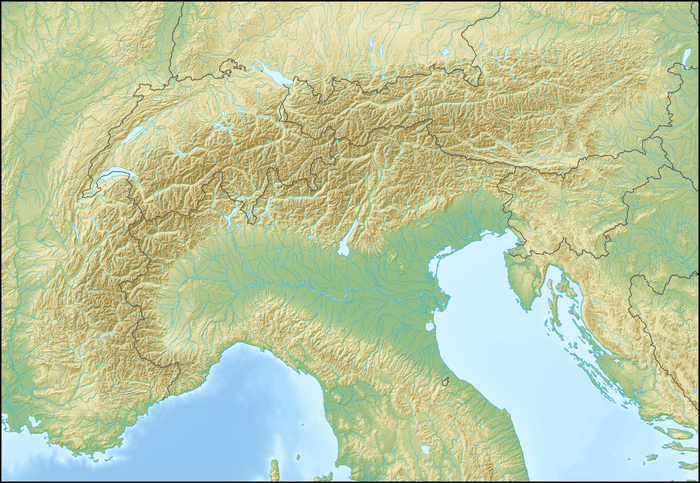Cresta Run
The Cresta Run is a natural ice skeleton racing toboggan track in eastern Switzerland. Located in the winter sports town of St. Moritz, the 1.2125 km (0.753 mi) run is one of the few in the world dedicated entirely to skeleton. It was built in 1884 near the hamlet of Cresta in the municipality of Celerina/Schlarigna by the Outdoor Amusement Committee of the Kulm Hotel and the people of St. Moritz. The committee members were Major William Henry Bulpett (eventual founder of the St. Moritz Tobogganing Club (SMTC)), George Robertson, Charles Digby Jones (Robertson and Digby Jones planned the proposed course), C. Metcalfe, and J. Biddulph. It has continued as a partnership to this day between the SMTC, founded in 1887, and the people of St. Moritz.

The sport of intramural sled racing originated in winter resort activities at the Kulm Hotel in St. Moritz during the early 1870s. SMTC members still congregate for lunch in the 'Sunny Bar' at the Kulm. In the early days of competitive sledding, the predominant style was luge-style racing, lying on one's back, but the invention of the flexible runner sled (Flexible Flyer) in 1887, known colloquially as 'the America', led to Mr. Cornish using the head-first style in the 1887 Grand National. He finished fourteenth due to some erratic rides but established a trend, and by the 1890 Grand National all competitors were riding head-first.[1] The head-first style for a time became known as 'Cresta' racing.
The sport and its history
The Cresta Run and the SMTC were founded by devotees of sledding (tobogganing in British parlance) who adopted a head-first (prone) technique of racing down an icy run, as opposed to the feet-first (supine) and somewhat faster luge race. Both evolving sports were natural extensions of the invention of steerable sleds during the early 1870s by British guests of the Kulm hotel in St. Moritz. These initial crude sleds were developed almost accidentally—as bored well-to-do gentlemen naturally took to intramural competition in the streets and byways of twisty mountainous downtown St. Moritz hazarding each other and pedestrians alike. This gave impetus to a desire to steer the sleds, and soon runners and a clumsy mechanism evolved to allow just that along the longer curving streets of the 1870s. This also allowed higher speeds on the longer runs. Local sentiments varied, but eventually complaints grew vociferous and Kulm hotel owner Caspar Badrutt built the first natural ice run for his guests, as he had worked hard to popularize wintering in the mountain resort, and did not want to lose any customers to ennui, nor his workforce to injury from errant sleds on the streets.
The run
The run's head (top) is located under the remains of a Twelfth Century church, torn down in 1890, known as the 'Leaning Tower'. The overall drop is 157 m (515 ft) and the gradient varies from 2.8 to 1 to 8.7 to 1 (length to drop).
The modern Cresta track is not shared with bobsled, unlike the first half-pipe sledding track built by hotelier Caspar Badrutt for his guests. Most of it is located within the contour of a steep ravine and is created anew each winter using the rocky ravine and banks of earth as a buttressing bulwark for iced packed snow. It is owned and operated by an all-male club created in 1885 by British military officers with the official name of the St. Moritz Tobogganing Club (SMTC), but is generally, and more often, referred to as 'The Cresta Run'. The exclusion of women from the course, which was enforced until December 2018, dates from the late 1920s and was instituted because of injuries to female racers and the belief, although never proven, that excessive sledding caused breast cancer. It took official effect in 1929, though women had been banned from competitive events several years earlier. In late 2018, St Moritz Tobogganing Club meeting members voted by a two-thirds majority to allow women to ride the Cresta Run again and become members.
The course has two entrances known as 'Top' and 'Junction' respectively, and two parts, or banks, known as 'Upper' 'and 'Lower'. The entrance at Junction is adjacent to the SMTC clubhouse and is about a third of the way down from Top as the sled slides. Similarly, the exit is simply called 'Finish' and given a typical average speed of more than 50 mph, an experienced rider will exit the course at more than 80 mph when riding from Top.
The track served as host of the skeleton event for both the 1928 and the 1948 Winter Olympics.[2][3] These were the only Olympics with skeleton until 2002.
Club information
The primary purpose of the 1300 member club founded in 1887 is "…the conduct of races and practice on the Cresta Run and the encouragement of tobogganing generally".[4] While not snobbish, the Cresta Club gathers well-to-do gentlemen and is totally amateur. There are many more luge and bobsled runs world-wide, but only one Cresta devoted to head first sledding. The club asserts that most of the other sledding sports are dominated by professionals and it is one of the last bastions of the true amateur in sports.
Like many social clubs, members are elected from a list of qualifiers called the Supplementary List. The course is open to anyone that meets the three criteria for making that list, and need not be English. It has a lot of clubbish rites such as the "Firework", the "Shuttlecock Club" and a dedicated drink, the "Bullshot". The highlight of the Shuttlecock Club is the yearly held Shuttlecock dinner. The dinner is organised by the Shuttlecock President. Prominent presidents were Constantin von Liechtenstein, Gianni Agnelli, Gunter Sachs, Sir Dudley Cunliffe-Owen, Rolf Sachs, Lord Dalmeny, Graf Luca Marenzi, Marc M.K. Fischer, Lord Wrottesley and Sven Ley. The club sponsors more than thirty races a season which generally runs from just before Christmas to late February. The track is opened as soon as it is seasonally possible to do so, and is kept open in the same weather-dependent manner as all natural ice and snow attractions.
Notable rider-members
Some notably good riders from the membership of the past were Nino Bibbia, Italy; the amateur runner and gentleman driver Giorgio Jegher, Jack Heaton, USA; and Billy Fiske, USA (the first American pilot killed in World War II as a volunteer in the "Millionaire Squadron"). In 1955 the then 71-year-old Lord Brabazon [5] won the Cresta Run Coronation Cup at an average speed of 71 km/h (44 mph).
Among the best riders in recent years: eight times Grand National Winner Swiss Franco Gansser, fifteen times Grand National Winner Lord Wrottesley finished fourth at the 2002 Olympic Winter Games and is the current Top record holder (49.92 in 2015), former Junction Record holder Johannes Badrutt (41.02 in 1999), and current Junction record holder German Magnus Eger (40.94 in 2017)[6]. Marcel Melcher was the youngest ever Winner (age 19, in 1979) of the Grand National.
Wing Commander Andy Green is the RAF's team captain for the Cresta Run. Green is an established driver of land speed record cars, and holds the current land speed record which he achieved in Thrust SSC. He will also drive the 1,000 mph car Bloodhound SSC.
The Baron Raunchy was reported to have had the slowest ride from Junction with a time of 380 seconds.
Women and the Cresta
Although since 1929 until December 2018 rules[7][8] forbade women riders, it was not always so.[9] For example, T. A. Cook records that, in 1895, various experiments were made by women on the Cresta, testing different riding positions on different styles of toboggan—although at that time women riders were encouraged to use only the lower half of the course. As well, Vera Barclay rode the Cresta Run from Top. She was followed by a young American, Charles Lowe Boorum, Jnr., who said, "See you at the finish". Boorum started too fast; he rode into Church Leap at such a speed; he crashed at Shuttlecock, was hit by his toboggan and died from a fractured skull in the early evening.
In 2019 Carina Evans, of Britain, became the first woman to descend the Cresta Run from Top since the ban on women riders was lifted in 2018.[7]
Towards the end of the season, there is a Ladies Event in which women compete from Junction by invitation only.
References
- About The St Moritz Tobogganing Club
- 1928 Winter Olympics official report. Part 2. p. 14. (in French)
- 1948 Winter Olympics official report. pp. 6, 23. (in French and German)
- St Moritz Tobogganing Club - Ride The Cresta
- Lord Brabazon with the skeleton
- https://www.cresta-run.com/ride-the-cresta/facts-about-the-cresta/
- "British mother becomes first woman to descend Cresta Run since ban on females is lifted". Telegraph.co.uk. Retrieved 2019-01-28.
- St Moritz Tobogganing Club Facts about the Cresta
- Notes on Tobogganing at St Moritz, Second Edition, Chapter IX, by T A Cook, 1896
External links
| Wikimedia Commons has media related to Cresta Run. |
- Official website
- Cresta Run FAQ page, includes some of the assertions noted or quoted above.
- Background and Course description
- Course on jogmap.de
- The Cresta Run on Google Maps

